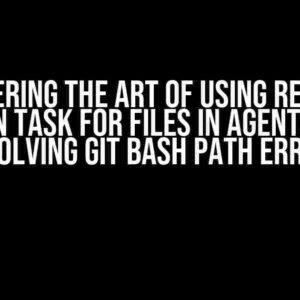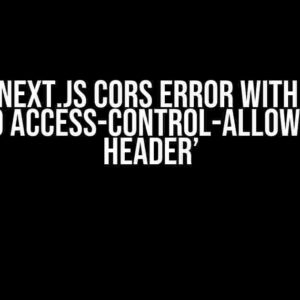Are you tired of scratching your head, wondering why your socket value is always null when received from the Context API? You’re not alone! In this article, we’ll dive into the possible reasons behind this frustrating issue and provide you with a step-by-step guide to debugging and resolving it.
Understanding the Context API and Sockets
The Context API is a powerful tool for managing state and side effects in React applications. It allows you to share data between components, making it easier to manage complex state changes. Sockets, on the other hand, enable real-time communication between the client and server, allowing for instantaneous updates and a more interactive user experience.
How Sockets Work with the Context API
When you use sockets with the Context API, you’re essentially creating a real-time communication channel between your React application and the server. The Context API acts as a centralized store for your application’s state, while the socket connection allows you to receive updates and push changes to the server in real-time.
import { createContext, useState, useEffect } from 'react';
import { io } from 'socket.io-client';
const SocketContext = createContext();
const SocketProvider = ({ children }) => {
const [socket, setSocket] = useState(null);
useEffect(() => {
const socket = io('https://example.com');
setSocket(socket);
}, []);
return (
<SocketContext.Provider value={{ socket }}>
{children}
</SocketContext.Provider>
);
};
export { SocketProvider, SocketContext };
In the above example, we create a SocketContext and a SocketProvider component. The SocketProvider initializes the socket connection using the io() function from the socket.io-client library and sets the socket state using the useState hook. The SocketContext is then used to share the socket instance with other components in the application.
Common Reasons Why Your Socket Value is Always Null
Now that we’ve covered the basics, let’s dive into the common reasons why your socket value might be always null when received from the Context API:
- Incorrect Socket Initialization
- Socket Connection Issues
- Inconsistent State Updates
- Misconfigured Context API
- Server-Side Issues
Incorrect Socket Initialization
One of the most common reasons for a null socket value is incorrect socket initialization. Make sure you’re importing the socket.io-client library correctly and initializing the socket connection with the correct URL.
import { io } from 'socket.io-client';
const socket = io('https://example.com', {
transports: ['websocket', 'polling']
});
In the above example, we’re importing the io function from the socket.io-client library and initializing the socket connection with the correct URL and transport options.
Socket Connection Issues
Another reason for a null socket value is socket connection issues. Ensure that your server is running and the socket connection is established successfully. You can use the socket.io-client’s built-in debugging features to troubleshoot connection issues.
import { io } from 'socket.io-client';
const socket = io('https://example.com', {
transports: ['websocket', 'polling'],
debug: true
});
socket.on('connect', () => {
console.log('Connected to the socket!');
});
socket.on('disconnect', () => {
console.log('Disconnected from the socket!');
});
In the above example, we’re enabling debug mode for the socket connection, which logs connection and disconnection events to the console.
Inconsistent State Updates
Inconsistent state updates can also cause a null socket value. Make sure you’re updating the socket state correctly using the useState hook.
import { useState, useEffect } from 'react';
import { io } from 'socket.io-client';
const [socket, setSocket] = useState(null);
useEffect(() => {
const socket = io('https://example.com');
setSocket(socket);
}, []);
In the above example, we’re using the useState hook to initialize the socket state and the useEffect hook to update the socket state when the component mounts.
Misconfigured Context API
A misconfigured Context API can also lead to a null socket value. Ensure that you’re creating and using the Context API correctly.
import { createContext, useState, useEffect } from 'react';
import { io } from 'socket.io-client';
const SocketContext = createContext();
const SocketProvider = ({ children }) => {
const [socket, setSocket] = useState(null);
useEffect(() => {
const socket = io('https://example.com');
setSocket(socket);
}, []);
return (
<SocketContext.Provider value={{ socket }}>
{children}
</SocketContext.Provider>
);
};
In the above example, we’re creating a SocketContext and a SocketProvider component. The SocketProvider initializes the socket connection and sets the socket state, which is then shared with other components using the Context API.
Server-Side Issues
Finally, server-side issues can also cause a null socket value. Ensure that your server is configured correctly and the socket connection is established successfully.
const express = require('express');
const app = express();
const server = require('http').createServer(app);
const io = require('socket.io')(server);
server.listen(3000, () => {
console.log('Server started on port 3000!');
});
In the above example, we’re creating an Express.js server and configuring socket.io to establish a socket connection.
Debugging and Resolving the Issue
Now that we’ve covered the common reasons for a null socket value, let’s walk through a step-by-step guide to debugging and resolving the issue:
- Check the Socket Initialization
- Verify the Socket Connection
- Check the State Updates
- Verify the Context API Configuration
- Check the Server-Side Configuration
By following these steps, you should be able to identify and resolve the issue causing the null socket value.
Conclusion
In conclusion, a null socket value when received from the Context API can be frustrating, but it’s often caused by common mistakes or misconfigurations. By following this guide, you should be able to identify and resolve the issue, ensuring a seamless and real-time communication channel between your React application and the server.
| Reason | Solution |
|---|---|
| Incorrect Socket Initialization | Verify the socket initialization and ensure the correct URL and transport options are used. |
| Socket Connection Issues | Enable debug mode and troubleshoot connection issues using the socket.io-client’s built-in features. |
| Inconsistent State Updates | Verify the state updates and ensure the socket state is updated correctly using the useState hook. |
| Misconfigured Context API | Verify the Context API configuration and ensure the SocketContext and SocketProvider components are used correctly. |
| Server-Side Issues | Verify the server-side configuration and ensure the socket connection is established successfully. |
By understanding the causes and solutions to a null socket value, you’ll be able to debug and resolve the issue efficiently, ensuring a robust and real-time communication channel between your React application and the server.
Final Thoughts
In conclusion, resolving a null socket value when received from the Context API requires attention to detail and a systematic approach to debugging. By following this guide, you’ll be able to identify and resolve the issue, ensuring a seamless and real-time communication channel between your React application and the server.
Remember, debugging is an essential part of the development process, and with patience and persistence, you can overcome even the most frustrating issues.
Happy coding!
Here is the FAQ section about “Why my socket value is always null when received from the Context Api”:
Frequently Asked Question
Getting a null value from the Context API can be frustrating, but don’t worry, we’ve got the answers to help you troubleshoot the issue!
Q: Is my Context API configuration correct?
Double-check that you’ve correctly configured your Context API and socket connection. Make sure you’ve imported the correct modules, and your API endpoint is correctly set up. Also, verify that your socket connection is established before trying to access the value.
Q: Am I using the correct data type to receive the socket value?
Verify that the data type you’re using to receive the socket value matches the type of data being sent by the Context API. If you’re expecting a JSON object, make sure you’re using a JSON-compatible data type. Similarly, if you’re expecting a string or integer, use the corresponding data type.
Q: Is my socket connection timing out or being closed prematurely?
Check if your socket connection is timing out or being closed too quickly. Make sure you’re not closing the connection before receiving the value, and that your timeout settings are adequate for the response time of the Context API.
Q: Are there any errors or exceptions being thrown that I’m not catching?
Verify that you’re properly handling errors and exceptions that may occur during the socket connection or data transmission. Check your error logs and catch any exceptions that might be causing the null value.
Q: Is my Context API endpoint rate-limited or experiencing high latency?
Check if your Context API endpoint is experiencing high latency or is rate-limited. This could be causing your socket connection to time out or return a null value. Verify the API documentation for any rate limits or latency requirements.
I hope these questions and answers help you troubleshoot and resolve the issue of receiving a null socket value from the Context API!



